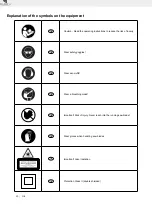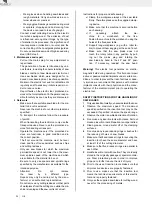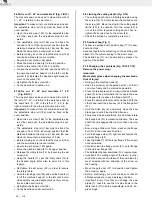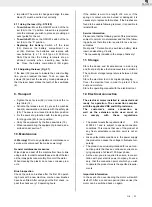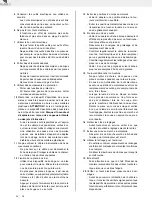
28
GB
B
A
M
A
T
O
Bavarian Machine Tools
8.8 Limiting the cutting depth (Fig. 3/14)
•
The cutting depth can be infinitely adjusted using
the screw (24). To do this loosen the knurled nut on
the screw (24). Move the stop for the cutting depth
limitre (25) to the outside. Turn the screw (24) in
or out to set the required cutting depth. Then re
tighten the knurled nut on the screw (24).
•
Check the setting by completing a test cut.
8.9 Sawdust bag (Fig. 1)
The saw is equipped with a debris bag (17) for saw
dust and chips.
Squeeze together the metal ring on the dust bag and
attach it to the outlet opening in the motor area.
The debris bag (17) can be emptied by means of a
zipper at the bottom.
8.10 Changing the saw blade (Fig. 15/16/17/18)
Remove the power plug!
Important.
Wear safety gloves when changing the saw blade.
Risk of injury!
•
Swing up the machine head (5).
•
Undo the screw (e) on the guide bar (37), so that it
can move freely and be pivoted downwards.
•
Press the release lever (3). Swing up the saw blade
guard (6) to the point where the recess in the saw
blade guard (6) is above the flange bolt (31).
•
Press the saw shaft lock (4) with one hand. With the
other hand insert the allen key (d) in the flange bolt
(31).
•
Hold the Allen key (d) and slowly close the saw
blade guard until it touches the Allen key.
•
Firmly press the saw shaft lock (4) and slowly rotate
the flange bolt (31) in clockwise direction. The saw
shaft lock (4) engages after no more than one rota
tion.
•
Now, using a little more force, slacken the flange
bolt (31) in the clockwise direction.
•
Turn the flange screw (31) right out and remove the
external flange (32).
•
Take the blade (7) off the inner flange (38) and pull
out downwards.
•
Carefully clean the flange screw (31), outer flange
(32) and inner flange (38).
•
Fit and fasten the new saw blade (7) in reverse order.
•
Important! The cutting angle of the teeth, in other
words the direction of rotation of the saw blade (7)
must coincide with the direction of the arrow on
the housing.
•
Move the guide bar (37) into position and tighten
the screw (e) again.
•
Before continuing your work make sure that all
safety devices are in good working condition.
•
Important! Every time that you change the saw
blade (7), check to see that it spins freely in the
table insert (11) in both perpendicular and 45° an
gle settings.
8.6 Mitre cut 0°- 45° and turntable 0° (Fig. 1/2/12)
The crosscut saw can be used to make mitre cuts of
0° 45° in relation to the work face.
Important
. To make miter cuts (inclined saw head),
the adjustable stop rail (16a) must be fixed at the
outer position.
•
Open the set screw (16b) for the adjustable stop
rail (16a) and push the adjustable stop rail out
wards.
•
The adjustable stop rail (16a) must be fixed far
enough in front of the innermost position that the
distance between the stop rail (16a) and the saw
blade (6) amounts to a maximum of 8 mm.
•
Before making a cut, check that the stop rail (16a)
and the saw blade (6) cannot collide.
•
Secure the set screw (16b) again.
•
Move the machine head (4) to the top position.
•
Fix the rotary table (14) in the 0° position.
•
Loosen the set screw (22) and use the handle (1)
to angle the machine head (4) to the left, until the
pointer (19) indicates the desired angle measure
ment on the scale (18).
•
Re-tighten the fixing screw (22).
•
Cut as described in section 8.3.
8.7
Mitre cut 0°- 45° and turntable 0°- 45°
(Fig. 2/4/13)
The crosscut saw can be used to make mitre cuts to
the left of 0° 45° in relation to the work face and, at
the same time, 0° 45° to the left or 0° 45° to the
right in relation to the stop rail (double mitre cut).
Important
. To make miter cuts (inclined saw head),
the adjustable stop rail (16a) must be fixed at the
outer position.
•
Open the set screw (16b) for the adjustable stop
rail (16a) and push the adjustable stop rail out
wards.
•
The adjustable stop rail (16a) must be fixed far
enough in front of the innermost position that the
distance between the stop rail (16a) and the saw
blade (6) amounts to a maximum of 8 mm.
•
Before making a cut, check that the stop rail (16a)
and the saw blade (6) cannot collide.
•
Secure the set screw (16b) again.
•
Move the machine head (4) to its upper position.
•
Release the rotary table (14) by loosening the set
screw (26).
•
Using the handle (11), set the rotary table (14) to
the desired angle (refer also to point 8.4 in this
regard).
•
Retighten the set screw (26) in order to secure
the rotary table.
•
Undo the locking screw (22) and use the handle (1)
to tilt the machine head (4) to the left until it coin
cides with the required angle value (in this connec
tion see also section 8.6).
•
Re-tighten the fixing screw (22).
•
Cut as described under section 8.3.







